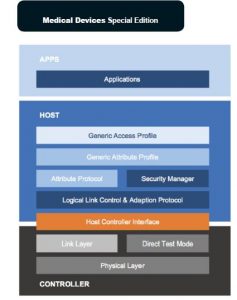The miniaturization of biomedical sensors, the proliferation of smartphones and the rise of power efficient wireless protocols has started a generation of wearable medical devices which stand to change the face of healthcare.
These medical wearables go way beyond fitness trackers. They’re not just counting steps or tracking heart rates, but monitoring glucose levels and blood pressure, managing chronic pain, or even delivering medication.
At the heart of this revolution in healthcare are wireless technologies which have arisen with the proliferation of the smartphone. Bluetooth and NFC are the wireless protocols driving this new generation of wearable medical devices.
The Wearable Revolution
Healthcare has traditionally been practiced in hospitals and private clinics, requiring patients to travel significant distances and delaying treatment. Wearable health technology promises to flip that on its head by enabling “telemedicine” – the administration of healthcare beyond clinical settings, to reach patients whether they’re at home, at work, or on the go.
Telemedicine enabled by wearable medical technology has the potential improve both inpatient and outpatient care. For instance, wearables have the potential to allow hospitals to focus resources on urgent care, as less serious ailments can be diagnosed, and in some cases even treated, remotely with the help of wearable medical devices.
Wearable health monitors can also let patients with more serious ailments shorten their hospital stays and go home earlier while staying monitored around the clock, thus freeing up beds and staff for other patients.
Wearable medical devices can help chronic disease sufferers manage and monitor their condition, and easily share their health information with their physician. Wearable medical devices can also provide convenient and economic access to healthcare services to poor, underserved communities, the disabled, and the mobility challenged.
Beyond improving the lives of those with diagnosed diseases, wearables can be used for preventative medicine. The next generation of fitness and health trackers may not just monitor your physical activity, but signs of impending illness to help you fend off serious health issues before they occur.


Contact geometry, orientation, and placement in the insulator can improve signal integrity performance and life cycle
Smarter Healthcare with Bluetooth Low Energy
The most important wireless protocol for medical wearables to have today is indisputably Bluetooth Smart, also known as Bluetooth Low Energy.
Despite its name, Bluetooth Smart is quite different from regular Bluetooth. Whereas Bluetooth classic was designed to stream data to and from peripherals such as headphones, microphones or keyboards, Bluetooth Smart was designed to be an extremely power-efficient protocol for transmitting short bursts of data from battery powered devices used in metering, monitoring, and sensing applications. That makes it the perfect wireless protocol for wearable medical devices.
Bluetooth Smart uses a different physical and link layer than Bluetooth Classic, but as part of the Bluetooth standard, all smartphones compatible with Bluetooth 4.0 and up are also compatible with Bluetooth Smart.
Bluetooth Smart also allows medical wearables to take advantage of the cellular connectivity, GPS location awareness, and powerful processing capabilities of a smartphone to supplement the device’s own capabilities.
A wearable health monitor can, for instance, share sensor data with a smartphone over Bluetooth Smart. The user can then open up the device’s healthcare app and view his vital signs. The user’s raw health data could also be cross checked against an online database to alert them of signs they are at risk of preventable diseases. That same data could be easily shared with caregivers or loved ones.
As a wireless protocol, Bluetooth Smart has been designed to be optimized for the short, bursty messages characteristic of IoT and wearable devices. Connections can be opened and closed extremely quickly, and message transmission times are short. While Bluetooth Classic connections take hundreds of milliseconds or more, Bluetooth Smart devices can establish a connection, transmit a message, and close the connection in tens of milliseconds. This fast messaging doesn’t just make for responsive devices, but also helps Bluetooth Smart minimize power consumption by maximizing the time the radio is turned off. Combined with a peak transmit power of about 15mA, this allows extremely efficient power usage, and there are Bluetooth Smart devices which can last months or even years off coin cell batteries.
Security is essential for medical applications and Bluetooth Smart doesn’t disappoint. It uses robust, 128-bit AES-CCM encryption, and Elliptic curve Diffie-Hellman key generation for protection against eavesdropping.
Implementing Bluetooth Smart can be done using network processors, HCI modules, or SoC chips. Network processors, also known as connectivity ICs, are Bluetooth radio modules with low power MCUs which implement the Bluetooth stack, minimizing the load on the host processor. This makes them appropriate for devices with a low power MCU.
HCI modules are bare-bones Bluetooth radio modules which implement physical and link layer, and rely on the host system to implement the upper layers of the Bluetooth stack. HCI modules are appropriate for devices which have a powerful host processor with the resources to run the Bluetooth stack in addition to application logic.
SoC chips combine Bluetooth radios with relatively powerful MCUs which can run the entire Bluetooth stack along with application logic all on the same chip. These can range in their processing capability. For instance, the Nordic nRF51822 uses an ultra-low-power consumption ARM Cortex M0 core for maximum power efficiency, while the nRF52832 has a Cortex M4 to support a broader variety of applications. For a majority of wearable applications, an SoC design will provide the best power efficiency, ease of integration and development cost. As a single chip design, SoC devices also lend themselves to small form factor, thin and light wearables.
With its ultra-low power consumption, widespread compatibility, and ease of implementation using SoC modules, it’s no wonder Bluetooth Smart is the number one wireless protocol for wearable devices today.
NFC

Unlike Bluetooth which allows devices up to 30 feet away to connect, NFC requires devices to be within 10cm or even less – practically touching. On the surface, NFC’s limited range seems like a drawback, but in fact it’s key to its success.
By requiring devices to be in extremely close proximity, NFC inherently makes sure that the right devices are connected. Whereas Bluetooth has a complicated pairing process involving selecting the right device and entering passcodes, NFC connections are “tap and go”. Users simply tap the devices together and a connection is automatically established, messages transmitted, and the connection closed.
The quick and intuitive usage of NFC makes it particularly attractive for elderly populations as well as hospital staff, as it means equipment can be deployed with minimal training.
The quick tap and go connections used by NFC are also well suited for clinical settings where multiple devices might need to be read by a centralized smartphone or other NFC reader. With Bluetooth, a connection would have to be manually setup for each separate device sequentially, but with NFC, each device is simply tapped as it needs to be read, without having to wade through a list of possibly dozens of devices in the vicinity.
NFC’s other main draw is its extremely attractive power consumption characteristics. NFC devices can often be passively powered – meaning the NFC device is powered by the RF field generated by the NFC reader. The amount of power generated is small, with a typical figure of 4mA at 3.3V, but it’s enough to power simple sensor readings.
Without the need for a battery, incredibly small and thin form factors can be made, making NFC an ideal technology for skin patch sensors, implantables, or clothing.
Because of its need for close proximity between devices, NFC provides a basic yet effective form of physical security and authentication, and greatly reduces the possibility of Man-in-the-Middle attacks. Like Bluetooth Smart, NFC also supports AES encryption, and Diffie-Hellman key exchange if an additional level of security is required.
NFC is a powerful technology when used on its own, but also works well in conjunction with other wireless technologies. Multiradio modules with both Bluetooth and NFC, for instance, can take advantage of Bluetooth Out of Band pairing where the device uses NFC to establish a secure Bluetooth connection using physical proximity. Users get the best of both worlds – the tap-to-connect security and convenience of NFC, with the range and continuous connectivity of Bluetooth.
Wearable Medicine
The potential of wearable medical devices is only just being realized. These devices have the power to move the centre of healthcare from the hospital to the home, potentially improving the lives of the elderly, chronically ill, and underserved populations such as the poor or disabled. Wearables also have the potential to improve the efficiency of hospitals, as well as help diagnose preventable diseases early on, before they transform into serious illnesses.
At the centre of the medical wearable revolution are two key technologies – Bluetooth Smart, and NFC. Bluetooth Smart provides an extremely low power consumption technology with widespread smartphone compatibility, while NFC is an extremely user-friendly technology that enables incredibly thin and light form factors and batteryless designs. Each of these wireless technologies has its own advantages for the current and coming wave of medical wearables.







